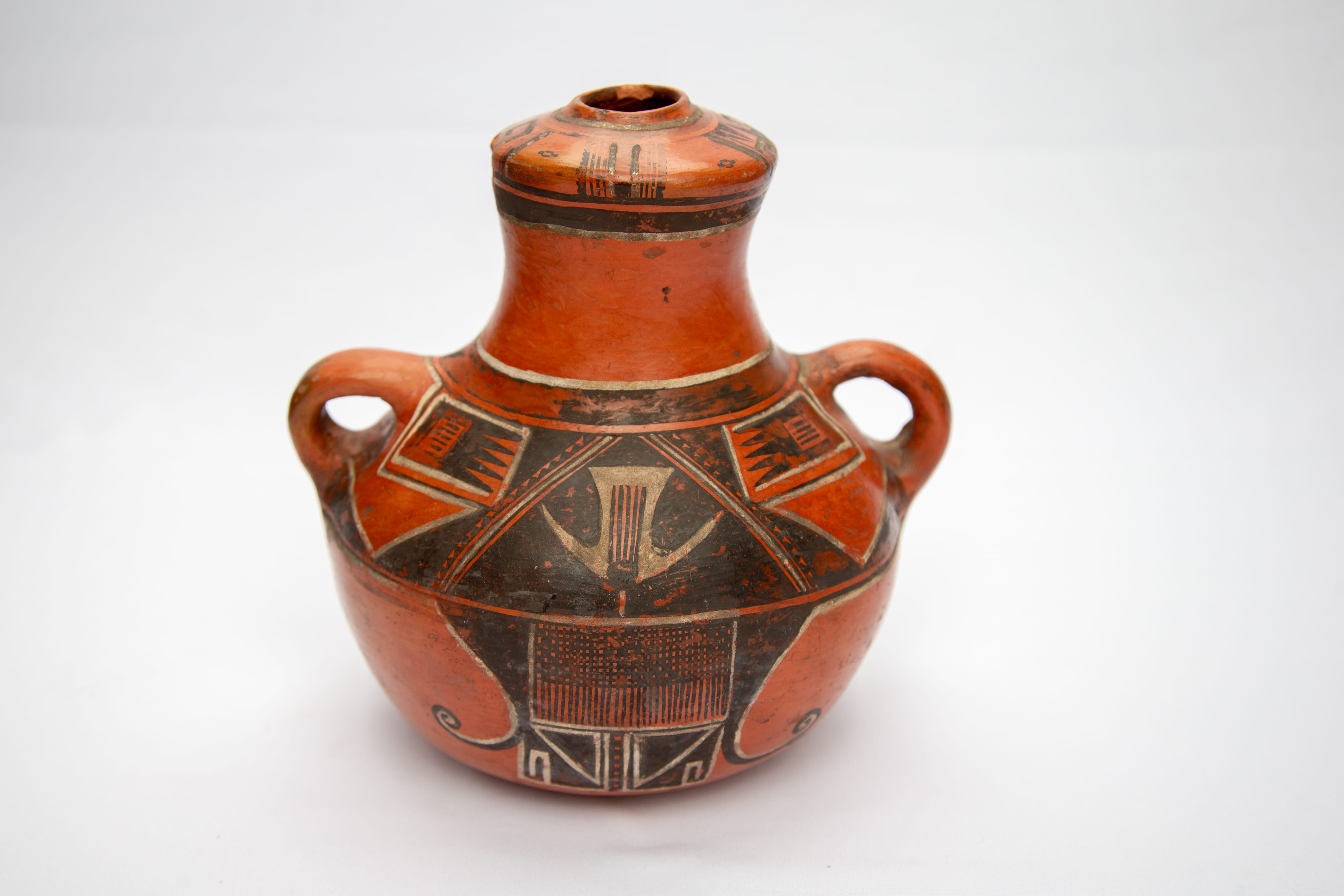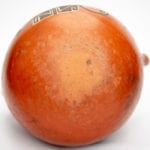The bottom bowl width of 8.75″ includes two 1.25″ handles.
Of the total height of 9.13 inches, about 86% (7.875″) is the bottom bowl and 14% (1.25″) is the top bowl.
The top bowl has a width of 3.4375″.
This is a large pot and is both physically and iconographically complex. It’s intriguing more than beautiful.
While most Hopi pottery is formed from a grey clay that fires to a beige-orange color, this pot is made from a yellow clay that fires to a dull red, like a brick. Both the worn bottom and inside have the same appearance. Where the pot has been polished, the surface has a more vibrant color. It’s not clear to me if the smoothed clay body was simply polished with a stone to produce this richer color or if a slip, perhaps using a fine-grained sample of the clay body, was applied and then polished to produce the surface finish.
 The shape is literally a marriage of two cultures. The bulk of the vessel is a European jug with handles. The top is a miniature prehistoric Sikyatki seedpot. A similar bi-lobed jar by Nampeyo and Annie is part of the Cooke Collection at The Museum of the West, Scottsdale. A photograph of the Cooke jar is shown here, Ed Wade estimates that the Cooke pot was made about 1900 — 1905 and I adopt those dates for pot 2018-02. At that time the Hopi mesas were remote and outsiders came to Hopi by wagon or on horse across the desert from Winslow, AZ, two-days to the south. Because of this remoteness, Hopi culture was still largely intact (Stephen, 1936). Nevertheless, by 1900 Anglo pots and buckets from Keam’s trading post (Graves, 1998) had largely replaced indigenous pottery for household use and almost all Hopi-Tewa and Hopi pottery was made for sale to outsiders. While there are eccentric Hopi bi-lobed jars that pre-date Columbus, jar 2018-02 was clearly made for sale. Thus the odd form of pot 1018-02 reflects the bifurcated experience of its makers: embedded in a Native culture while selling to European-Americans.
The shape is literally a marriage of two cultures. The bulk of the vessel is a European jug with handles. The top is a miniature prehistoric Sikyatki seedpot. A similar bi-lobed jar by Nampeyo and Annie is part of the Cooke Collection at The Museum of the West, Scottsdale. A photograph of the Cooke jar is shown here, Ed Wade estimates that the Cooke pot was made about 1900 — 1905 and I adopt those dates for pot 2018-02. At that time the Hopi mesas were remote and outsiders came to Hopi by wagon or on horse across the desert from Winslow, AZ, two-days to the south. Because of this remoteness, Hopi culture was still largely intact (Stephen, 1936). Nevertheless, by 1900 Anglo pots and buckets from Keam’s trading post (Graves, 1998) had largely replaced indigenous pottery for household use and almost all Hopi-Tewa and Hopi pottery was made for sale to outsiders. While there are eccentric Hopi bi-lobed jars that pre-date Columbus, jar 2018-02 was clearly made for sale. Thus the odd form of pot 1018-02 reflects the bifurcated experience of its makers: embedded in a Native culture while selling to European-Americans.
During the first few years of the 20th century, Annie experimented with painting black designs on red pots, often highlighting the edges of the designs with while kaolin paint. This pot is the first such example in this collection. Annie was a versatile painter, sometimes painting with an uncluttered style that is difficult to distinguish from her Mother’s work (cf 2009-04) and at other times finding her own style with a more crowded, detailed and precise design than her Mom’s (cf. 1994-02). The painting on jar 2018-02 is a good example of Annie’s unique crowded style. The same design is painted on both sides of the jar, though on one side the design is substantially eroded while on the other side it is intact. Below the handles is a detailed variation of the classic “eagle tail” design that became a hallmark of Nampeyo’s career (2005-16) but Annie has radically-altered her Mother’s design. Above the eagle tail Annie drew a complex set of elements that fill the space up to the base of the neck. The minature seedjar that crowns the pot has a design incorporating four motifs, the pattern repeated twice. There’s a lot going on here. It’s as if Annie challenged herself to fit as much detail as possible into the available space.
Specifically, Nampeyo’s rendition of the eagle tail design (2005-16) has a central open square with an imbedded and pointed “batman” image above the three tails. Annie has filled a similar square with about 30 vertical lines, their top half being crossed by about 10 horizontal lines. The result is a dense comb form with a tight crosshatch as a handle. Below, Nampeyo’s three flowing linear tails have been replaced by Annie with two chunky solid black squares showing white kaolin triangles in their top left quadrant and a white crook in the bottom right quadrant. Flanking this central section are two finely-drawn curvilinear wings that are the lightest element on pot 2018-02, and are similar to Nampeyo’s wings, except that Annie has outlined the design with white. Overall this eagle tail design is much heavier and lacks the motion of Nampeyo’s work.
The design above the eagle tail design spans the width of the handles, about 2.5 inches. At the center is a large black triangle. In its center a design in the form of a descending white dove. Again Annie has chosen to complicate this motif: the core of the dove is left unpainted but this space is embellished with five vertical lines. Flanking the central triangle the design is so detailed that it defies a simple verbal description. Along the sides of the central triangle are two parallel lines in an unpainted surface, except that the space between the lines has been filled with white paint, like a highway with an esplanade and two single lanes. A chain of three solid triangular forms are fitted along this highway and extended to the handles, a white line bordering their edges. The vertical edge of the upper of the three triangles forms one side of an open box drawn with parallel black-over-white lines. Inside the box is a black wing element with five pointed feathers. In the center of the wing is a unpainted square. Annie leaves nothing unembelished: 4 or 5 horizontal black lines are drawn in this square. Above the handles the neck of jar 2018-02 is ringed with a thick black band surmounted by a white line. Overall this is a complicated and crowded design.
Crowning the European base is a small Sikyatli seedpot with a detailed design in minature. The flying-saucer shape of this pot was favored by prehistoric potters and later Nampeyo because the expansive upper surface offered a wide canvass for design, but here this surface is only 1.5 inches wide. Nevertheless, Annie has filled it with an intricate design worthy of a large pot. Viewed from the top, the design is repeated two times. One element is a cluster of four thick and six thin parallel lines. If the two renditions are rotated to the 12 and 6 o’clock positions, the sequence of lines is one thick black line followed by three thin black lines, then a thick white line, followed by a gap. The the sequence is then repeated in reverse order, starting with the thick white line.
Many years ago bowl 1996-05 was sold to me a “by Nampeyo,” though Barbara Kramer thinks it is more likely by Annie. One design on that bowl is a element that looks like two bricks with a space in between and caped by a third brick. A design element on jar 2018-02 suggests that Barbara might be correct. After the cluster of paralle lines, this same brick design is repeated using four brick shapes, two separated bricks with one brick on top and one on the bottom closing off the space. Each “brick” is perfectly drawn, though the overall grouping is tiny. This four-brick design is taken from prehistoric Sikyatki pottery; one example is at the Museum of Northern Arizona. Three more vertical lines proceed the next design on pot 2018-02, the largest and most complicated on the seedpot. The design forms around a thick black vertical line crossed by adjoining black and white lines., forming four quadrents. The bottom two and upper right quadrants contain squared-off crooks. The upper right crokk moves in a counter clockwise direction, the botton left crook is clockwise on one side of the jar and counter clockwise on the other. The botton right crook is clockwise on one side and obliterated by a chip on the other. On both sides the upper left quadrant is unpainted except for two black scalene triangles set slightly apart. The unpainted areas in this quadrant thus form residual scalene triangles with the black design berween them. The viewer’s eye flips between seeing two black triangles on an unpainted surface or two unpainted triangles imbeded in a black surface, “ground-forground reversal.” Another set of thin, black, thick black and thick white lines separates this large design from a second rendition of the four piled bricks, completing one circuit of design. Encircling the slightly rised neck of the seedpot is a faded black line enclosing a white line.
The detail and precision of design on jar 2018-02 are impressive, though the overall crowded effect is not particularly engaging. This is a Baroque Hopi-Tewa jar; more is better. It’s two pots in one, each filled with as much detail of design as possible. The form and design both dazzle and tire the eye. It’s an exhausting tour-de-force.













